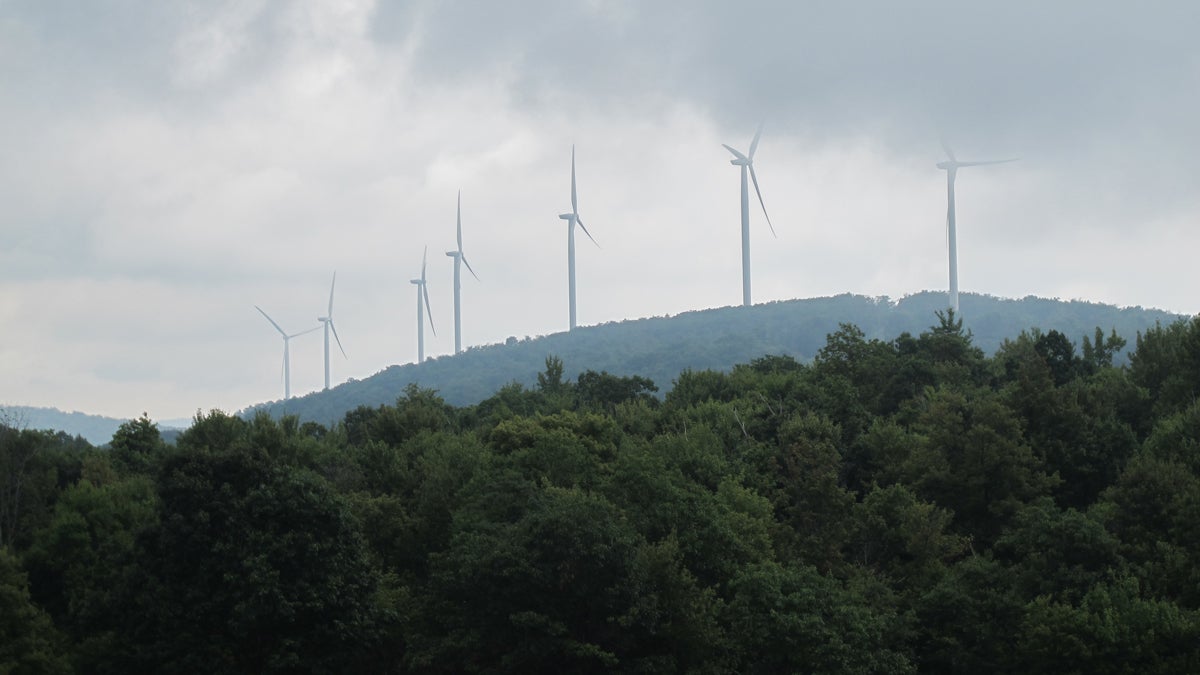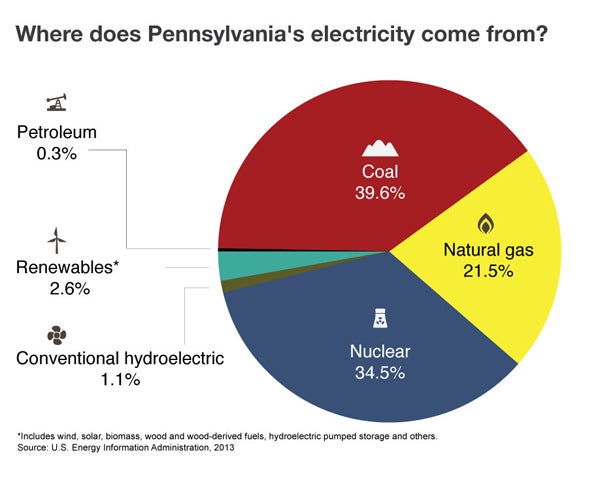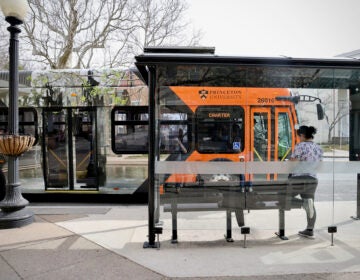Wind in Pennsylvania a boom-or-bust business
Listen
The Twin Ridges Wind Farm has 68 turbines along the Big Savage Ridge in Somerset County, Pa. (Katie Colaneri/StateImpact)
Heading eastbound on the Pennsylvania Turnpike, just as you approach the Somerset service plaza, a striking sight appears in the distance: six huge, white metallic blooms rising above a forested ridge.
That’s how you know you’re in wind country. Somerset County is home to eight of Pennsylvania’s 25 commercial wind farms.
[Part two of five]
Pennsylvania is third in the nation for energy production. It’s also in third place for carbon dioxide emissions. As the federal government pushes states to cut emissions that are leading to climate change, StateImpact Pennsylvania profiled five major energy sources: coal, wind, nuclear, solar and oil.
Twin Ridges Wind Farm
Heading eastbound, just as you approach the Somerset service plaza, a striking sight appears in the distance: six huge, white metallic blooms rising above a forested ridge.
That’s how you know you’re in wind country. Somerset County is home to eight of Pennsylvania’s 25 commercial wind farms.
‘It all starts up there.’
John Bennett is site manager at Twin Ridges wind farm about 20 miles south of the turnpike, near the Maryland border. He points to one of the farm’s 68 turbines, towering overhead at a height of more than 260 feet.
“It all starts up there,” he says. “The wind is turning the rotor and the rotor is turning a gear box that turns the generator and that’s how we make the power.”
However, the morning I visit Twin Ridges, the wind isn’t blowing.
Bennett explains when you’re driving by a wind farm and don’t see the massive blades spinning, it doesn’t necessarily mean there’s nothing happening inside the turbines.
“It’s thinking right now,” he says, “It’s watching and as soon as it sees the winds are enough that we can produce power, it’ll come out of standby mode by itself, pitch up and start running.”
Modern turbines run on a system of computerized controls and sensors that are constantly monitoring wind speed and direction.
The blades are programmed to turn into or out of the wind, and the oval body – called the “nacelle” — can turn 360 degrees to catch as much as possible. Bennett can even control them from home on his tablet.
A boom-or-bust business
Enormous and high-tech as these things are, Pennsylvania’s 720 wind turbines only provide a tiny amount of the state’s electricity – about 1.5 percent. There is room to grow. The National Renewable Energy Laboratory estimates wind can supply as much as three times that amount of power.
However, after a decade of growth, development has recently slowed down in Pennsylvania.
“What the data’s been showing is that it’s cheaper to install wind power in places in the middle of the country,” says Costantin Samaras, assistant professor of Civil and Environmental Engineering at Carnegie Mellon University.
Wind projects can be difficult to finance in Pennsylvania’s “deregulated” or competitive electricity market, which favors short-term contracts, and the cost of building new transmission lines to connect wind farms to the grid can be prohibitively expensive.
At the end of 2013, Congress allowed a key federal tax credit to expire and has shown no signs of renewing it yet. The production tax credit (PTC), which gave wind developers 2.3 cents for every kilowatt hour of electricity produced, has come and gone several times since it was first introduced in 1992.
Michael Speerschneider is Chief Permitting and Public Policy Officer at EverPower Wind Holdings, the Pittsburgh-based company behind the Twin Ridges wind farm. He says the uncertainty of the PTC has made wind a boom-or-bust business, with developers rushing to get projects started before the credit expires.
The Spanish wind turbine manufacturer, Gamesa cited that as one reason for closing down a plant in western Pennsylvania earlier this year.
But developers like EverPower expect wind to gain strength again – even without the PTC.
Pennsylvania’s Alternative Energy Portfolio Standard, passed in 2004, requires utilities to purchase increasing amounts of power each year from renewable sources. The ultimate goal is to reach 18 percent in six years.
Some environmental groups are pushing to increase the standard to 30 percent by 2030.
“By really shifting heavily towards wind and solar and other renewable energies and energy efficiency, we can cut global warming pollution and grow a stronger clean energy economy,” says Adam Garber with PennEnvironment.
‘When are you going to take your hands off the bike?’
Upping Pennsylvania’s renewable energy capacity is one option the state will have for cutting carbon dioxide emissions under a new proposal from the federal Environmental Protection Agency.
However, the Corbett administration is skeptical that more government incentives are the right way to accomplish that goal.
“There’s a difference between a little shove at the beginning to get you started,” says Patrick Henderson, the governor’s Energy Executive. “And then the question is when are you going to take your hands off the bike?”
The state’s Republican-controlled House recently ordered a study on the impact of wind as compared to other energy sources like natural gas, coal and nuclear.
State Representative Kathy Rapp of Warren County says she sponsored the resolution because of its impact on wildlife.
According to the Pennsylvania Game Commission, each wind turbine kills 26 bats and four birds on average each year. With 720 turbines currently installed, that amounts to 21,600 mortalities. The commission has been studying the issue since 2007 when it brokered a voluntary cooperative agreement with wind developers to mitigate these impacts.
“The fatality of wildlife is one issue,” Rapp says. “The other issues are… what are the amount of subsidies for these turbines and what’s the imprint of actual acreage… and what are the impacts to the electric grid?”
The Joint State Government Commission will complete the study by next year when the EPA expects to finalize its Clean Power Plan.
Speerschneider acknowledges that wind, like every source of energy, has its down sides. But he argues there are good reasons to make sure it can compete in a fossil fuel-dominated industry.
“In today’s markets, there’s no real way to value what wind brings to the energy mix,” he says. “What the Clean Power Plan does is start to provide that value and recognize the societal and the economic value of zero emission generation sources.”
However, with some lawmakers and other sectors of the energy industry lining up to oppose EPA’s proposal, it’s hard to tell which way the wind will blow.
How do renewable energy sources impact the electrical grid? And just what is “the grid” anyway?
Listen to Professor Gregory Reed, Director of the Electric Power Initiative at the University of Pittsburgh’s Swanson School of Engineering, as he explains.

Credit: Rachel Feierman for NewsWorks/WHYY
WHYY is your source for fact-based, in-depth journalism and information. As a nonprofit organization, we rely on financial support from readers like you. Please give today.




